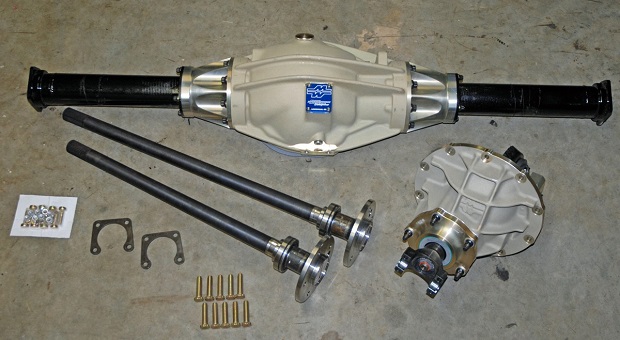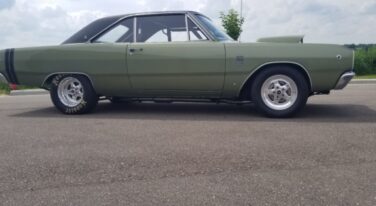
Mark Williams Modular Rear Ends Part 1
Click Here to Begin Slideshow
One of the latest technological advancements in Pro Modified is the use of modular aluminum rear end housings in place of sheet metal and otherwise fabricated housings. A number of heavy hitters have made the switch, and with good reason - we’ll get into that down the page. The housings of choice are Mark Williams’ 11-inch ring gear modulars. This basic housing design has been successfully used on Top Alcohol dragsters and funny cars for a number of years. Williams revised the 11-inch setup to include a robust 4-link system, which turned out to be the perfect match for today’s big power Pro Modified cars.
Of course, there are several reason why many racers have made the change – not the least of which is the fact these new rear end assemblies incorporate a special (proprietary to Mark Williams) 11-inch diameter ring and pinion. Gear life is improved dramatically. All the housings are engineered with reinforced ribbing that adds to the structural strength of the assembly. Another reason for the increase in popularity is the fact that all critical areas of the housings are precision machined to +/- 0.001-inch. This means the housings prove dead nuts accurate. Because of this, the axles, spool, bearings and pinion are all in proper alignment. The end result is less horsepower lost to parasitic drag coupled with much (much!) improved rear end reliability.
Fair enough. But all of this comes with a cost. A typical Pro Mod full floater four link housing with brakes can range anywhere from $13,450 all the way up to $17,000, or even higher. That’s a good-sized chunk of change, but it’s also the cost of racing a 4-5000+ horsepower car today. Most certainly, the average little guy can’t afford and doesn’t have a need for a rear end of this caliber.
But wait: What if you could have a similar rear end assembly that didn’t cost nearly as much and at the same time offered many of the performance advantages found in the big 11-inch Pro Mod modular? M-W has you covered there too, with their Modular 9-inch and Modular 12-bolt housings (the focus here is on the Modular 9-inch). These housings share many design and material features of their 11-inch Pro Mod big brothers, but without the cost. They’ve been available for a couple of years and you have to question why we don’t see more of them in bracket race, street machine and street rod applications.
There’s more to the Modular 9-inch housing: Essentially, it’s based upon a cast aluminum, precision CNC-machined housing center. Then, by coupling any number of different aluminum bells or steel tubes, one can create a rear end that physically bolts into a given car. Mark Williams offers just about every piece used in their housings as separate parts. The modular concept allows you to incorporate a variety of end bells and mounting brackets to suit your particular application. The inherent parts interchange with the modular means you (or M-W) can build just about any combination, from a specific width four link arrangement all the way out to a simple leaf spring package, to bare housing as shown in the accompanying photos. Basically, it’s a custom car builder’s dream.
Our focus here is on the modular housings with steel axle tubes. Just like their Pro Mod and Top Alcohol big brothers, the key ingredient is a reinforced cast aluminum center housing module made from a proprietary grade of aerospace aluminum alloy that is extraordinarily strong (60,000 P.S.I. – that’s a 30% improvement over 6061 aluminum). The center section is a completely machined assembly that is produced with extremely accurate precision. There is zero stress from bending and welding, typical to fabricated housing or a conventionally braced rear axle housing. Mark Williams CNC-machines everything in-house (in this case, using a horizontal axis machining center). This ensures that the housing is properly aligned for optimum internal efficiency.
The main bearing bore in this housing is sized at 3.250 inches, which means you can use a 35 spline aluminum spool or a 40 spline steel spool, or any number of different limited slip or Detroit Locker differentials (we’ll examine the third members later). Internally, the center section of the housing is designed with a healthy bulkhead at each end where the end bells attach. If you do your homework, you’ll find that many so-called sheet metal housings lack this internal support.
Externally, the aluminum center of the modular is machined in several locations to accept any number of sway bars and/or anti roll bars along with four link bottom braces. Additionally, the housing is fitted with a billet filler bung along with a drain port. You’ll note the raised boss with a blue aluminum cover in the photos. What’s with that? Simple. The rear end housing is engineered to accept a pressure lubrication pump that can also incorporate a cooler. M-W manufactures a complete fluid pump kit specifically for this application. The raised boss also makes a great location for a tail lamp on an altered or dragster (NHRA Rules). Williams offers the tail lamp kit separately.
For a closer look at the housing, check out the accompanying photos. And stay tuned. Next issue, we’ll examine the various housing bells and axle arrangements. The possibilities here are almost endless.
One of the latest technological advancements in Pro Modified is the use of modular aluminum rear end housings in place of sheet metal and otherwise fabricated housings. A number of heavy hitters have made the switch, and with good reason - we’ll get into that down the page. The housings of choice are Mark Williams’ 11-inch ring gear modulars. This basic housing design has been successfully used on Top Alcohol dragsters and funny cars for a number of years. Williams revised the 11-inch setup to include a robust 4-link system, which turned out to be the perfect match for today’s big power Pro Modified cars.
Of course, there are several reason why many racers have made the change – not the least of which is the fact these new rear end assemblies incorporate a special (proprietary to Mark Williams) 11-inch diameter ring and pinion. Gear life is improved dramatically. All the housings are engineered with reinforced ribbing that adds to the structural strength of the assembly. Another reason for the increase in popularity is the fact that all critical areas of the housings are precision machined to +/- 0.001-inch. This means the housings prove dead nuts accurate. Because of this, the axles, spool, bearings and pinion are all in proper alignment. The end result is less horsepower lost to parasitic drag coupled with much (much!) improved rear end reliability.
Fair enough. But all of this comes with a cost. A typical Pro Mod full floater four link housing with brakes can range anywhere from $13,450 all the way up to $17,000, or even higher. That’s a good-sized chunk of change, but it’s also the cost of racing a 4-5000+ horsepower car today. Most certainly, the average little guy can’t afford and doesn’t have a need for a rear end of this caliber.
But wait: What if you could have a similar rear end assembly that didn’t cost nearly as much and at the same time offered many of the performance advantages found in the big 11-inch Pro Mod modular? M-W has you covered there too, with their Modular 9-inch and Modular 12-bolt housings (the focus here is on the Modular 9-inch). These housings share many design and material features of their 11-inch Pro Mod big brothers, but without the cost. They’ve been available for a couple of years and you have to question why we don’t see more of them in bracket race, street machine and street rod applications.
There’s more to the Modular 9-inch housing: Essentially, it’s based upon a cast aluminum, precision CNC-machined housing center. Then, by coupling any number of different aluminum bells or steel tubes, one can create a rear end that physically bolts into a given car. Mark Williams offers just about every piece used in their housings as separate parts. The modular concept allows you to incorporate a variety of end bells and mounting brackets to suit your particular application. The inherent parts interchange with the modular means you (or M-W) can build just about any combination, from a specific width four link arrangement all the way out to a simple leaf spring package, to bare housing as shown in the accompanying photos. Basically, it’s a custom car builder’s dream.
Our focus here is on the modular housings with steel axle tubes. Just like their Pro Mod and Top Alcohol big brothers, the key ingredient is a reinforced cast aluminum center housing module made from a proprietary grade of aerospace aluminum alloy that is extraordinarily strong (60,000 P.S.I. – that’s a 30% improvement over 6061 aluminum). The center section is a completely machined assembly that is produced with extremely accurate precision. There is zero stress from bending and welding, typical to fabricated housing or a conventionally braced rear axle housing. Mark Williams CNC-machines everything in-house (in this case, using a horizontal axis machining center). This ensures that the housing is properly aligned for optimum internal efficiency.
The main bearing bore in this housing is sized at 3.250 inches, which means you can use a 35 spline aluminum spool or a 40 spline steel spool, or any number of different limited slip or Detroit Locker differentials (we’ll examine the third members later). Internally, the center section of the housing is designed with a healthy bulkhead at each end where the end bells attach. If you do your homework, you’ll find that many so-called sheet metal housings lack this internal support.
Externally, the aluminum center of the modular is machined in several locations to accept any number of sway bars and/or anti roll bars along with four link bottom braces. Additionally, the housing is fitted with a billet filler bung along with a drain port. You’ll note the raised boss with a blue aluminum cover in the photos. What’s with that? Simple. The rear end housing is engineered to accept a pressure lubrication pump that can also incorporate a cooler. M-W manufactures a complete fluid pump kit specifically for this application. The raised boss also makes a great location for a tail lamp on an altered or dragster (NHRA Rules). Williams offers the tail lamp kit separately.
For a closer look at the housing, check out the accompanying photos. And stay tuned. Next issue, we’ll examine the various housing bells and axle arrangements. The possibilities here are almost endless.


![[Gallery] Okolona Street Rods Kentuckiana V Foundation Car Show](https://www.racingjunk.com/news/wp-content/uploads/2022/04/IMG_0774-e1650040587750-376x206.jpg)
![[Gallery] Road Rats Car Show](https://www.racingjunk.com/news/wp-content/uploads/2022/05/2A-e1651770667920-376x206.jpg)


Leave a Reply